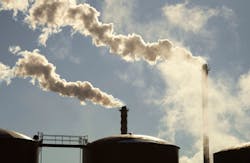Industrial emissions have caused a reduction in rainfall in the northern tropics, according to a new study.
Researchers reconstructed rainfall patterns going back more than 450 years by analyzing the chemical composition of a stalagmite recovered from a cave in Belize, Central America. They looked at the isotope values of the stalagmite, with more negative values associated with wet conditions and less negative values associated with dry conditions.
The team, led by experts at Durham University in northeast England, identified a substantial drying trend from 1850 onwards. This coincides with a steady rise in sulphate aerosols in the atmosphere as a result of fossil fuels being burnt to drive the industrial boom in Europe and North America.
Nine shorter dry spells were also identified since 1550 following major volcanic eruptions in the Northern Hemisphere that produced similar emissions to those produced by burning fossil fuels.
The researchers believe this provides very strong evidence that any injection of sulphate aerosols into the upper atmosphere can lead to shifts in rainfall patterns.
As a result of this pollution, the Intertropical Convergence Zone (ITCZ) — a tropical rainfall belt near the equator — shifted towards the warmer Southern Hemisphere, causing dryer conditions in the northern tropics, Durham University reported.
Lead author Dr. Harriet Ridley, from the Department of Earth Sciences at Durham University, said: "The research presents strong evidence that industrial sulphate emissions have shifted this important rainfall belt, particularly over the last 100 years.
"Although warming due to man-made carbon dioxide emissions has been of global importance, the shifting of rain belts due to aerosol emissions is locally critical, as many regions of the world depend on this seasonal rainfall for agriculture.
"The role of sulphate aerosols in repositioning the ITCZ was previously identified using computer modelling, but until now no suitable climate record existed to support those ideas.
"Our research allows us to make more accurate predictions about future climate trends and it appears that regional sulphate aerosol production is an essential factor to include in these predictions."
The findings of the study have been published in the journal Nature Geoscience.
